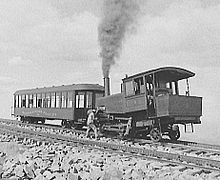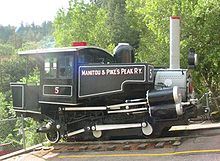- Manitou and Pike's Peak Railway
-
Manitou and Pike's Peak Railway 
Cog Train at the 14,110 feet (4,301 m) summit of Pikes Peak.Locale El Paso County, Colorado, USA Dates of operation 1889– Track gauge 4 ft 8 1⁄2 in (1,435 mm) (standard gauge) Length 8.9 mi (14.3 km) Headquarters Manitou Springs, Colorado The Manitou and Pike's Peak Railway (also known as the Pikes Peak Cog Railway) is an Abt rack system cog railway in Colorado, USA, climbing the well-known mountain Pikes Peak. The base station is in Manitou Springs, Colorado near Colorado Springs.
The railway is the highest in North America by a considerable margin. It was built and is operated solely for the tourist trade.
Contents
History
The railway was started by Zalmon G. Simmons, inventor and founder of the Simmons Beautyrest Mattress Company. The company was founded in 1889 and limited service to the Halfway House Hotel was started in 1890. The summit was reached the following year.
A number of steam locomotives were built for the line by the Baldwin Locomotive Works, all rack-only locomotives with steeply inclined boilers to keep them level on the average 16% grades. Operating steam locomotives on such a line was back-breaking work and expensive, so when more modern forms of traction became available, the railway was eager to modernize.
A gasoline-powered railcar was constructed in 1938, believed to be the first rack railcar in the world. It was designed to be a cheaper alternative to the steam locomotives enabling economic service during quieter times of the year. Proving a huge success, the railway soon bought more internal combustion engined trains. This car is still in operation on the mountain, though it is a different color than originally.
The next were five 'streamlined' diesel locomotives from General Electric, which were equipped with matching passenger cars, acquired from 1939 onward.[1] These slowly supplanted the steam locomotives, though some steam operations persisted until the 1960s as backup power and to operate the snow-clearing train (where their greater weight meant they were less likely to derail). A number of the steam locomotives are now on static display, in Manitou and elsewhere, and the Railway still has an operational steam locomotive (#4) and an original coach. However, the steam locomotive was actually put out of service for many years before being retrieved from a museum and brought back to service in 1980.
In 1964 the railway needed more equipment, but General Electric was not interested in the business, so the railway went abroad, to Switzerland, home of the vast majority of the world's cog railways. In 1964, the Swiss Locomotive and Machine Works in Winterthur provided two bright red railcars (railcars contain a seating compartment as well as engineer stand, eliminating the need for a separate pushing locomotive), very similar to equipment in use on many Swiss railways. Two more were provided in 1968 when the first two proved their worth. These locomotives, and all locomotives following are now powered by biodiesel.
With increasing tourism in the 1970s, the railway needed more capacity, and in 1976 took delivery of two larger two-car articulated railcars from the Swiss Locomotive Works of Winterthur. At about the same time, passing sidings were built in several places, allowing trains to pass at various points on the mountainside. Previously, trains could pass only at the Mountain View siding, permitting only three trains a day up the mountain. With the new equipment and sidings, eight trains per day became possible (two more larger railcars were delivered from SLM; one in 1984 and the last, Unit 25, in 1989).
Rolling stock on the M&PPRy. consists of: four 214 passengers articulated Swiss-built railcars; four 78 passenger Swiss-built railcars; three GE built locomotives (one of which has been modifies to carry the section crew); one snowplow (#22 - built upon the frame of a GE locomotive); one 23 passenger diesel railcar (#7); one steam locomotive (#4 - built by Baldwin); a Winter-Weiss "streamliner" coach and an original Wasson wooden coach (#104)
Manitou Incline
More commonly called simply the "Manitou Incline," the Mount Manitou Scenic Incline Railway -- actually a funicular up the side of a peak called Rocky Mountain located adjacent to Mount Manitou -- was operated by the Manitou and Pike's Peak Railway until the Incline was closed by a rockslide in 1990. This line's lower terminus was adjacent to the Cog Railway base station in Manitou Springs. The Manitou Incline averaged almost a 40% grade—gaining 2,011 feet (613 m) in elevation over a length of approximately 1 mile (1.6 km)-with the maximum grade being 68%.
The Manitou Incline was initially built in 1907 for use in construction of city water lines and a hydroelectric plant. When the construction was finished, the Manitou and Pike's Peak Railway took over the cable car as a tourist operation.
From 1990 forward, the defunct Incline has been controversial because, although theoretically off-limits to the public, its roadbed has in fact been heavily used for recreation and exercise. As of 2008, the future of the Incline could include an official opening to the public, a more intense guard patrol to keep the public out, or an ambitious attempt to reclaim the land and eradicate the highly visible scar from the side of Rocky Mountain[2][3].
Today
As of 2006 the railway owns enough equipment (railcars and snow plows) to run six to eight trains per day from mid-May through mid-September. During "off-peak" months (mid-September through mid-December and mid-March through mid-May), anywhere from one to five trains are run per day, with additional trains added if there is sufficient demand.
The railway was generally closed from mid-December through mid-March unless the snow plows were able to clear the line; however, in 2006, the railway began year-round service. Winter service varies according to demand (in January, for example, trains run once a day on weekends and holidays).
See also
- List of Colorado historic railroads
- List of heritage railroads in the United States
- Mount Washington Cog Railway
References
- ^ "Famous Cog Railway Goes Streamline" Popular Science, November 1939
- ^ Inclineclub
- ^ Incline
External links
- Manitou and Pike's Peak Railway home page
- Information on the Manitou Incline trail
- The Pikes Peak Web site
Categories:- Heritage railroads in Colorado
- Mountain railways
- Manitou Springs, Colorado
- Pikes Peak
- Visitor attractions in El Paso County, Colorado
- Rack railways in the United States
- Transportation in El Paso County, Colorado
Wikimedia Foundation. 2010.









